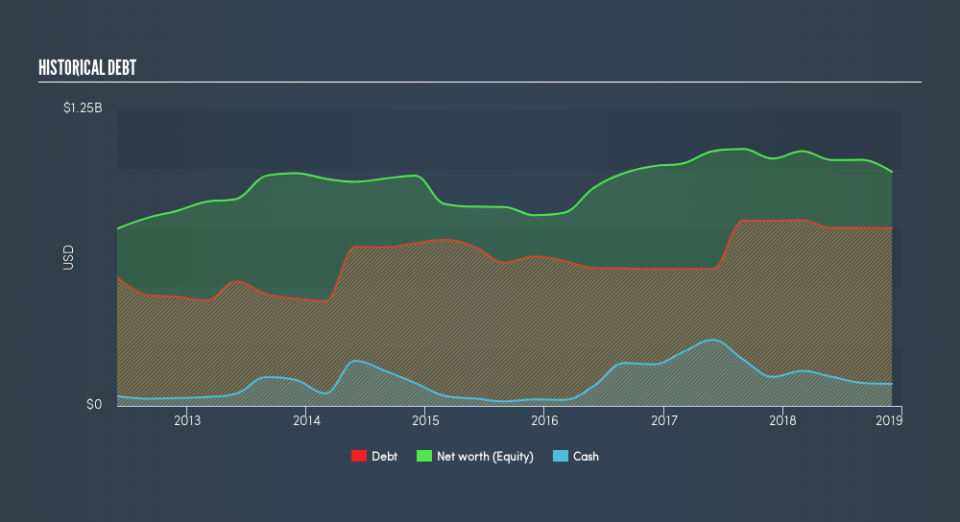Are Worthington Industries, Inc.’s (NYSE:WOR) Interest Costs Too High?

Small-cap and large-cap companies receive a lot of attention from investors, but mid-cap stocks like Worthington Industries, Inc. (NYSE:WOR), with a market cap of US$2.3b, are often out of the spotlight. Surprisingly though, when accounted for risk, mid-caps have delivered better returns compared to the two other categories of stocks. Let’s take a look at WOR’s debt concentration and assess their financial liquidity to get an idea of their ability to fund strategic acquisitions and grow through cyclical pressures. Don’t forget that this is a general and concentrated examination of Worthington Industries’s financial health, so you should conduct further analysis into WOR here.
View our latest analysis for Worthington Industries
Does WOR produce enough cash relative to debt?
Over the past year, WOR has maintained its debt levels at around US$750m which accounts for long term debt. At this stable level of debt, WOR currently has US$93m remaining in cash and short-term investments , ready to deploy into the business. Moreover, WOR has produced US$254m in operating cash flow during the same period of time, resulting in an operating cash to total debt ratio of 34%, signalling that WOR’s operating cash is sufficient to cover its debt. This ratio can also be interpreted as a measure of efficiency as an alternative to return on assets. In WOR’s case, it is able to generate 0.34x cash from its debt capital.
Can WOR meet its short-term obligations with the cash in hand?
Looking at WOR’s US$551m in current liabilities, it appears that the company has been able to meet these obligations given the level of current assets of US$1.2b, with a current ratio of 2.16x. Generally, for Metals and Mining companies, this is a reasonable ratio as there’s enough of a cash buffer without holding too much capital in low return investments.
Is WOR’s debt level acceptable?
With debt reaching 76% of equity, WOR may be thought of as relatively highly levered. This is not unusual for mid-caps as debt tends to be a cheaper and faster source of funding for some businesses. No matter how high the company’s debt, if it can easily cover the interest payments, it’s considered to be efficient with its use of excess leverage. A company generating earnings after interest and tax at least three times its net interest payments is considered financially sound. In WOR’s case, the ratio of 4.84x suggests that interest is appropriately covered, which means that lenders may be inclined to lend more money to the company, as it is seen as safe in terms of payback.
Next Steps:
Although WOR’s debt level is towards the higher end of the spectrum, its cash flow coverage seems adequate to meet obligations which means its debt is being efficiently utilised. This may mean this is an optimal capital structure for the business, given that it is also meeting its short-term commitment. This is only a rough assessment of financial health, and I’m sure WOR has company-specific issues impacting its capital structure decisions. I suggest you continue to research Worthington Industries to get a more holistic view of the mid-cap by looking at:
Future Outlook: What are well-informed industry analysts predicting for WOR’s future growth? Take a look at our free research report of analyst consensus for WOR’s outlook.
Valuation: What is WOR worth today? Is the stock undervalued, even when its growth outlook is factored into its intrinsic value? The intrinsic value infographic in our free research report helps visualize whether WOR is currently mispriced by the market.
Other High-Performing Stocks: Are there other stocks that provide better prospects with proven track records? Explore our free list of these great stocks here.
We aim to bring you long-term focused research analysis driven by fundamental data. Note that our analysis may not factor in the latest price-sensitive company announcements or qualitative material.
If you spot an error that warrants correction, please contact the editor at editorial-team@simplywallst.com. This article by Simply Wall St is general in nature. It does not constitute a recommendation to buy or sell any stock, and does not take account of your objectives, or your financial situation. Simply Wall St has no position in the stocks mentioned. Thank you for reading.

